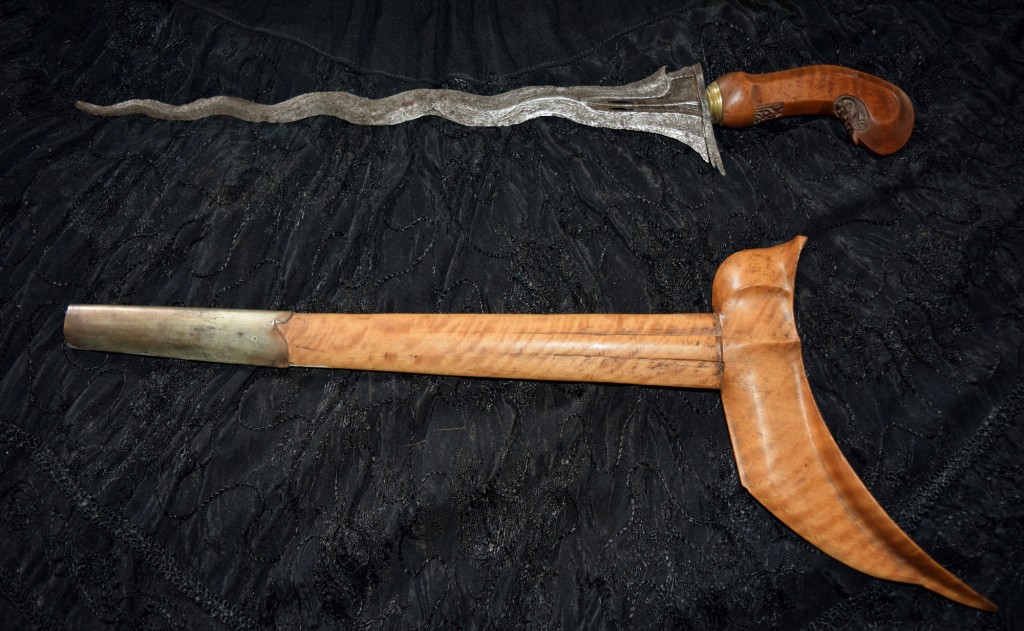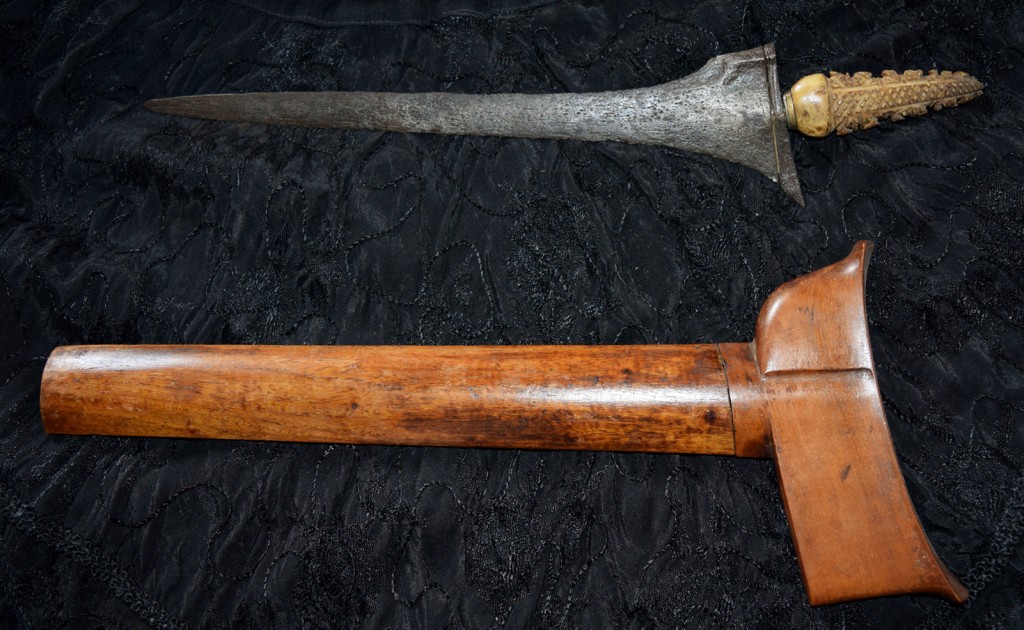 Indonesian
Indonesian
The Kris
by Michael A. W. Griffin
The sinuous blade on display was definitely a Kris – the mystical and lethal, traditional weapon of the Malays. The stallholder in Needham Market issued a warning. “There are many copies and I can’t really tell, but I think it’s a good one”. ‘It’ was a beautiful example, in the sort of condition which told that it could have been a cosseted antique or a ceremonial wedding Kris preserved by a family proud of its tradition.
The abundance of curios for sale from, and in South East Asia can be confusing. The casual buyer, seeing a poorly plated Kukri offered alongside a replica samurai sword, near a Bornean hilang or Malay kris might dismiss all, without further thought, daunted by the task of authentication.
Allegedly over a thousand years old, the Kris is supposed to have been the successor of daggers made from the bones of stingrays and it figures in stories of the Mahajapit Empire of the 13th century. It also appears in tales of the early Malaccan Sultanate, in particular the Hang Tuah legends, which feature acts of heroism and chivalry. Hang Tuah, the hero, was a bodyguard of the Sultan Mansur Shah who rewarded his bravery by presenting to him, the kris of a vanquished enemy. The name of the famed weapon was Tamin Sari. It is now the property of the Sultan of Perak.
Unlike most foreign daggers, the Malay hilt appears bent, to provide a four or five inch “pistol grip” facilitating its use as a thrusting weapon. Balinese or other Indonesian hilts are usually straight. The woodcarving represents Hindu deities. Local carvers work freehand on the hilt but the sheath, traditionally made from finely grained “ornamental wood”, is rarely carved. It will be polished and may be decorated with silver or ivory trim. There are relatively recent examples of ivory hilt, sheath and trim but these are usually modern “bridegroom ornaments” and they probably became popular with Asian carvers, due to the increased availability of African ivory. Amongst the historic weapons are regional variants where Arabic, Quranic quotations may be displayed on the blade. These were etched or engraved, then filled with silver. There is a smaller defensive kris, which has a curved (six inch), one-sided blade. Its name in Malay might remind you of the spurs of the fighting cocks – Lawi Ayam. It has been fascinating to meet a number of Malay ironsmiths in workshops as far apart as Trengannu and Brunei who still make a few ceremonial Kris for weddings and national display. All these craftsmen have a fund of ‘Kris’ stories, from those featuring the legendary Hang Tuah, to the more contemporary about ‘The Father of Malaysia’, Tungkhu Abdul Rahman. If you travel east, intent on buying in village markets, it would be worth learning some Malay language. Being able to discuss the history and mystery associated with the weapons will help your price and extend to you folklore, hospitality and, with luck, some of the mystery and fascination of the antique Kris.
A Kris is made in three parts. The blade, usually over twelve inches long, is wrought from iron. When red-hot, it is heated, beaten and drawn, then laminated with different iron ores often including meteoric metal, until the sinuous shape begins to form. It is filed and shaped into an uneven number of curves and small steps in the laminations serrate the edges. Not all Kris have curved blades these were functional weapons and not simply ceremonial.


The flat finish, usually given a ‘damascene type’ appearance, is sharpened to warrant the description “sharp as a razor.”
Caution – The modern welding, forging process, often includes pieces of hardened metal from vehicle parts – even bicycle chain – offering a superior alloy.

However, the early iron from Persia, with meteorite additives, added mystery as well as strength.

Unlike most foreign daggers, the Malay hilt appears bent, to provide a four or five inch “pistol grip” facilitating its use as a thrusting weapon. Balinese or other Indonesian hilts are usually straight. The woodcarving represents Hindu deities. Local carvers work freehand on the hilt but the sheath, traditionally made from finely grained “ornamental wood”, is rarely carved. It will be polished and may be decorated with silver or ivory trim. There are relatively recent examples of ivory hilt, sheath and trim but these are usually modern “bridegroom ornaments” and they probably became popular with Asian carvers, due to the increased availability of African ivory. Amongst the historic weapons are regional variants where Arabic, Quranic quotations may be displayed on the blade. These were etched or engraved, then filled with silver. There is a smaller defensive kris, which has a curved (six inch), one-sided blade. Its name in Malay might remind you of the spurs of the fighting cocks – Lawi Ayam. It has been fascinating to meet a number of Malay ironsmiths in workshops as far apart as Trengannu and Brunei who still make a few ceremonial Kris for weddings and national display. All these craftsmen have a fund of ‘Kris’ stories, from those featuring the legendary Hang Tuah, to the more contemporary about ‘The Father of Malaysia’, Tungkhu Abdul Rahman. If you travel east, intent on buying in village markets, it would be worth learning some Malay language. Being able to discuss the history and mystery associated with the weapons will help your price and extend to you folklore, hospitality and, with luck, some of the mystery and fascination of the antique Kris.
©M A W Griffin 1999



